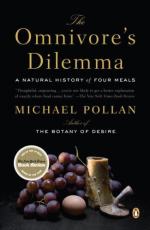
|
| Name: _________________________ | Period: ___________________ |
This test consists of 15 multiple choice questions and 5 short answer questions.
Multiple Choice Questions
1. Pollan points out that the Republic of _______ exists today because of all of the excess corn in the market.
(a) Excess.
(b) Diabetes.
(c) Obesity.
(d) Fat.
2. How many atoms does corn utilize during photosynthesis, unlike others?
(a) Three.
(b) Two.
(c) Four.
(d) One.
3. _________ Farm started out as a small farm that sold pre-bagged salad mix, according to the book.
(a) Greenworks.
(b) Earthbound.
(c) Earthville.
(d) Waterworks.
4. What is the name of the person who began to take away the programs to help the farmers?
(a) Ed Burrow.
(b) Dwight Eisenhower.
(c) Gerald Ford.
(d) Earl Butz.
5. To help combat how much a person can eat, the food industry has created ________ starch that can allow people to eat more.
(a) Liquid.
(b) Truthful.
(c) Resistant.
(d) Combatant.
6. The Naylor farm has turned from a diverse farm to one that has become a _________ production mecca.
(a) Soybean.
(b) Barley.
(c) Wheat.
(d) Corn.
7. Corn ________ early on to mass produce, but this also made the plant dependent on humans and animals.
(a) Grew.
(b) Died.
(c) Mutated.
(d) Reproduced.
8. Salatin's ______ invented many of the methods of farming that are used on the farm today.
(a) Mother.
(b) Father.
(c) Brother.
(d) Aunt.
9. Where does Pollan find himself first questioning what the food on the market is made of?
(a) Forest.
(b) Farm.
(c) Camp.
(d) Supermarket.
10. The soda industry began to ______ their sodas, which led people to drink more and to buy more.
(a) Add nutrients.
(b) Supersize.
(c) Change the names of.
(d) Add contests to.
11. What store does Pollan go to in order to begin creating a store-purchased organic meal?
(a) Cassandra's.
(b) Trader Joe's.
(c) Whole Foods.
(d) Richard's Organic Foods.
12. What do many farmers rely on in order to create higher yields at their farms?
(a) GMOs.
(b) Fertilizers.
(c) Pesticides.
(d) Water.
13. Pollan learns that most organic _______ comes from factory farms, even though they seem to be "better."
(a) Vegetables.
(b) Milk.
(c) Chips.
(d) Crackers.
14. Pollan points out that the industrial method of farming has led to increased ________ and polluted groundwater.
(a) Oil wells.
(b) Food supplies.
(c) Pollution.
(d) Energy.
15. Though the process of _________, animals can be fed, which then leads to the feeding of humans, too.
(a) Hard work.
(b) Seasons.
(c) Photosynthesis.
(d) Water.
Short Answer Questions
1. To combat the human end of the imperfect system, marketers add ______ to their raw product -- making it a novelty.
2. What takes corn meal, corn starch, and corn sweetener to make?
3. By _______, the government became involved in the organic market, as it sought to define what it meant to be organic.
4. What is the process by which corn is changed into different parts?
5. The _________ is one of the specialized animals that Pollan points out as having no issues with eating.
|
This section contains 424 words (approx. 2 pages at 300 words per page) |

|




